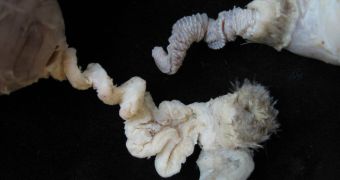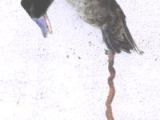Duffy Duck wages a tough war, but rather with his own wife than with Bugs Bunny.
Ducks are known to detain the record of penis size amongst vertebrates, compared to their own size: a specimen of Argentine blue-bill duck had a remarkable 42.5 cm (17 inches) long penis at a body length of 20 cm! (Could you imagine a 6 ft (1.8 m) tall man having a 13.3 ft (4 m) long penis?).Moreover, ducks' penises are very bizarre: beside a great variation a half-inch (1.2 cm) to 17 inches long, they are extremely variable in shape, from smooth to covered with spines, grooves and variably curled.
But what for?
A new research has found a huge surprise unnoticed by ornithologists till now: similar female genitalia correspond to such penises, apparently evolved to turn it difficult for males to successfully mate against the female's will. What's interesting is that most birds lack penises: just 3 % of all living bird keep one from reptilian ancestors and is seen as a primitive trait: ostriches (and related kiwi and tinamous) and waterfowl (ducks, geese, swans).But what penises have those that do have!...
Till now, it was thought that these penises were just the result of the male competition to fertilize females. But the research team discovered unexpectedly that while birds have vaginas (oviducts) like simple tubes, the vaginas of female waterfowl are just as ornate as male genitalia, with many "dead ends" (lateral sacs) and other countermeasures, seemingly designed to impede successful fertilization.
"If the phallus were to enter one of these sacs, it would not progress further into the oviduct where it would deposit sperm more effectively." said lead researcher Patricia Brennan, behavioral ecologist from both Yale University and the University of Sheffield in Britain.
Ducks' oviducts also possess some tight, clock-wise spirals.
"Interestingly, the male phallus is also a spiral, but it twists in the opposite, counterclockwise, direction," said co-researcher Richard Prum, Yale ornithologist.
"So, the twists in the oviduct appear designed to exclude the opposing twists of the male phallus, behaving like the opposite of a lock-and-key system."
The complexity of sacs and spirals in the waterfowl vagina has been found to be linked to the male penis length amongst the 14 species of ducks and geese investigated by the team, pointing to a war between the sexes in controlling mating.
"Despite the fact that most waterfowl form monogamous pairs, forced copulations by other males-the avian equivalent of rape-are common in many waterfowl," said Prum.
The "rape" frequency is strongly linked to the penis development.
"In response to male attempts to force their paternity on females, female waterfowl may be able to assert their own behavioral and anatomical means of controlling who fathers their offspring. Some large waterfowl that are highly monogamous, like geese and swans, have small phalluses, whereas other species that are quite small but more promiscuous have more elaborate genitalia," Brennan said.
"A larger phallus is advantageous in situations where there is more promiscuity, while more monogamous species have a much reduced phallus."
The researchers speculate that when a female agrees with a chosen male partner, her cooperation could help the penis bypass the complicated defenses.
"If the female is constantly struggling during unwanted copulations, this may prevent the phallus from being able to bypass the blind pouches," Brennan told LiveScience.
These amazing findings "help dispel the notion that females are simply passive members of the battle between the sexes," said evolutionary biologist Robert Montgomerie at Queen's University at Kingston in Canada, not involved in the research.
"This study, and many like it, serve to remind us that we should pay equal attention to both sexes when it comes to the process of making babies."
"Other species that exhibit forced copulation behavior, although rare, should be examined" for similar adaptations to their anatomy," added ornithologist Kevin Johnson at the Illinois Natural History Survey in Champaign.

 14 DAY TRIAL //
14 DAY TRIAL // 
